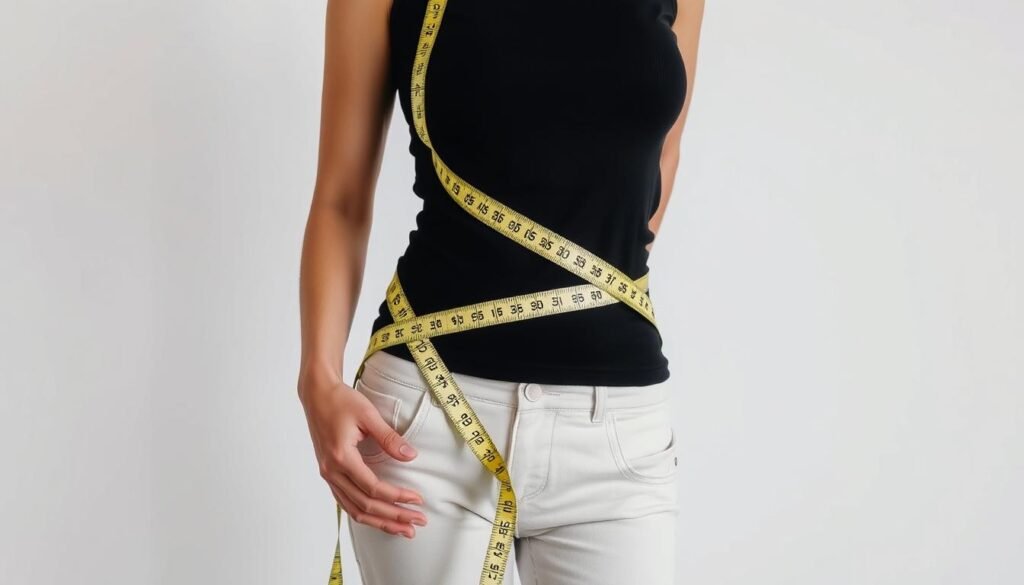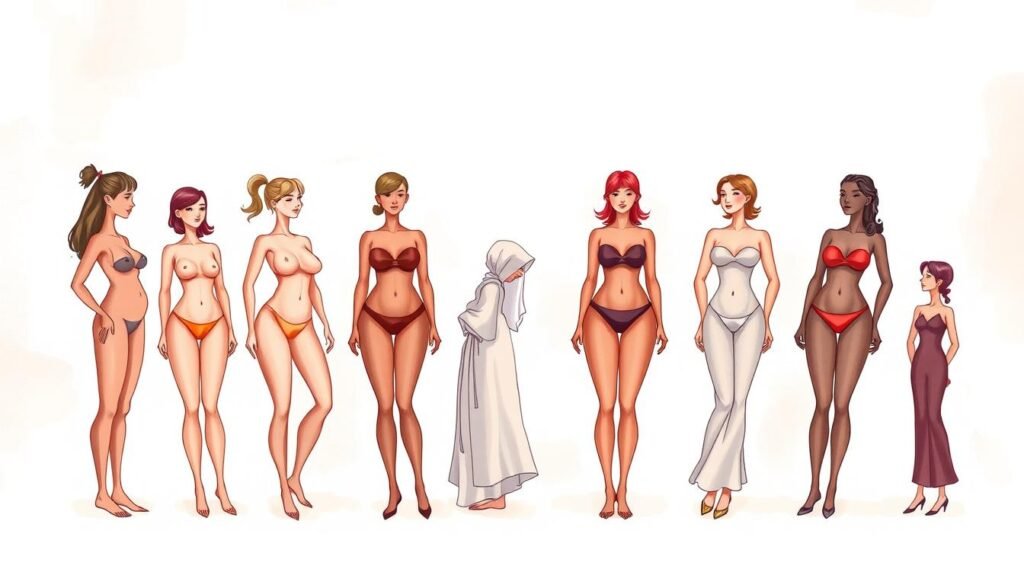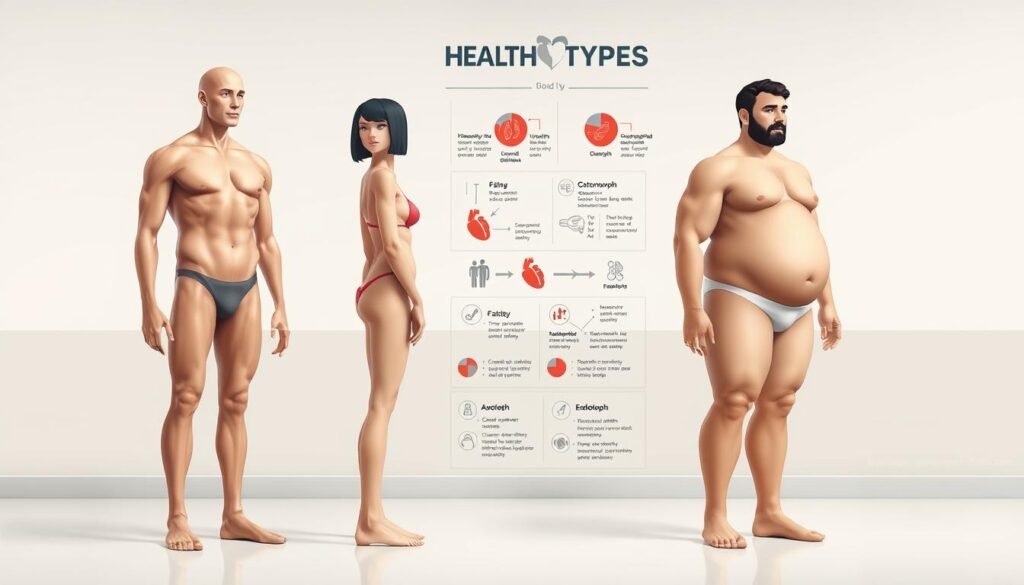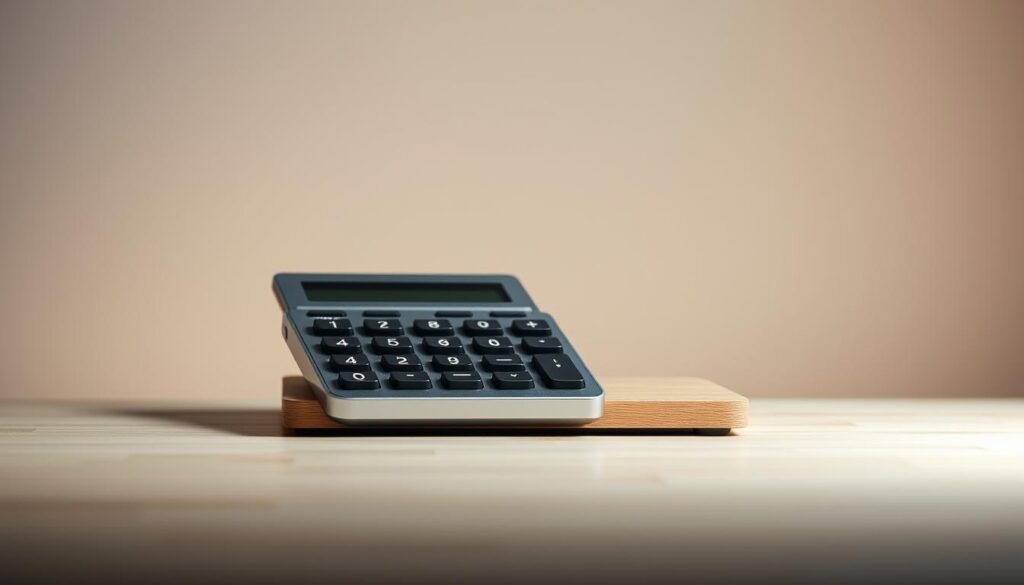Understanding your body shape is more than just about aesthetics; it’s about embracing your unique proportions and making informed fashion choices. Our body type calculator is designed to help you identify your silhouette based on your key measurements.
By determining your body shape, you can unlock a world of stylish outfit ideas tailored to your figure. Our calculator categorizes your shape into various classifications, including hourglass, triangle, and rectangle types, providing you with a clear understanding of your body shape.
Not only will you discover your body shape, but you’ll also gain insights into your waist-hip ratio, a significant indicator of overall health. Our calculator is designed to promote a positive body image, rather than striving for an ideal shape.
Key Takeaways
- Learn how to determine your body shape using our comprehensive calculator.
- Understand the different body shape classifications and their characteristics.
- Discover how knowing your body shape can improve your fashion choices.
- Gain insights into the importance of waist-hip ratio for overall health.
- Embrace your unique proportions and promote a positive body image.
Understanding Body Types and Why They Matter
In the pursuit of a healthier and more confident self, understanding body types plays a pivotal role. Body shape and type are influenced by a combination of genetic, hormonal, and lifestyle factors. The way our bodies distribute fat, muscle, and bone mass determines our overall shape, which can be categorized into different types.
Our body shape is primarily determined by genetic factors, including bone structure, muscle distribution, and natural fat deposition patterns. Hormones also play a significant role in body shape development, particularly during puberty, pregnancy, and menopause, when the body undergoes significant changes.
What Determines Your Body Shape
Several factors contribute to an individual’s body shape. Genetic predisposition is a significant determinant, influencing bone density, muscle mass, and fat distribution. Hormonal fluctuations throughout life can also affect body shape, as can lifestyle choices such as diet and exercise.
The main factors that determine body shape can be broken down into:
- Genetic factors, including bone structure and natural fat distribution
- Hormonal influences, particularly during significant life events
- Lifestyle choices, such as diet and physical activity levels
| Factor | Influence on Body Shape |
|---|---|
| Genetics | Determines bone structure, muscle distribution, and fat deposition patterns |
| Hormones | Significant during puberty, pregnancy, and menopause, affecting body shape |
| Lifestyle | Diet and exercise influence body composition and shape |
Benefits of Knowing Your Body Type
Understanding your body type can have numerous benefits, from improving your self-perception to guiding your fitness and health choices. By knowing your body shape, you can make informed decisions about clothing styles that complement your natural proportions, enhancing your appearance and confidence.
Moreover, being aware of your body type can help you tailor your fitness routine to target areas that align with your body’s natural structure, potentially leading to more effective workouts. It can also provide insights into potential health risks associated with certain body shapes, allowing for proactive health management.
Ultimately, understanding and embracing your body type can lead to improved self-acceptance, as you focus on your natural proportions rather than comparing to unrealistic ideals. This self-awareness is a crucial step towards a healthier and more positive body image.
How to Take Accurate Body Measurements

To get the most out of our body type calculator, you’ll need to take precise body measurements. This involves understanding where to measure and how to use a measuring tape effectively.
Required Measurements for the Body Type Calculator
Our body type calculator requires four essential measurements: bust, waist, high hip, and hips. To measure your bust size, wrap the tape around the fullest part of your breasts while wearing a properly fitted bra. For your waist size, measure around the smallest circumference of your natural waist, just above the belly button.
The high hip size is measured around the upper swell of the hip, approximately 7 inches (18 cm) below the natural waist. Lastly, measure your hip size around the largest circumference of your hips, typically over the largest part of your buttocks.
Tips for Getting Precise Measurements
To ensure accuracy, stand straight with your arms relaxed at your sides and feet together. Use a soft, flexible measuring tape that won’t compress your skin. Make sure the tape is snug but not too tight, and keep it parallel to the floor. For difficult measurements, consider having a friend assist you. Take each measurement twice to confirm accuracy and record the numbers immediately.
By following these guidelines, you’ll be able to obtain the precise measurements needed for our body type calculator, ensuring you get an accurate classification of your body shape.
The 7 Female Body Shape Classifications
Our body type calculator identifies seven female body shapes, helping you discover your silhouette. Understanding these classifications can guide your fashion choices and help you feel more confident in your clothing.
The seven body shapes are determined by the relationship between your bust, waist, and hips measurements. Let’s dive into the characteristics of each shape.
Hourglass and Variations
The hourglass figure is characterized by a well-defined waist and balanced proportions between bust and hips. There are variations within this category, including the top hourglass and bottom hourglass.
A top hourglass has a bust measurement significantly larger than the hips, while a bottom hourglass has hips larger than the bust. The formulas for these classifications are as follows:
- Hourglass: If (bust – hips) ≤1″ AND (hips – bust)
- Top Hourglass: If (bust – hips) >1″ AND (bust – hips)
- Bottom Hourglass: If (hips – bust) ≥3.6″ AND (hips – bust)
Triangle and Inverted Triangle
The triangle or pear body shape features narrower shoulders and bust with wider hips. In contrast, the inverted triangle has broader shoulders and bust compared to hips.
The triangle shape is defined by the formula: If (hips – bust) ≥3.6″ AND (hips – waist)
Rectangle and Spoon Body Types
The rectangle or straight body shape has minimal difference between bust, waist, and hip measurements, creating a straighter silhouette. The spoon body shape is similar to the triangle but with a more defined shelf-like appearance to the hips and a clearly defined waist.
The rectangle is classified by: If (hips – bust) 2″ AND (hips – waist) ≥7″ AND (high hip/waist) ≥1.193.

| Body Shape | Key Characteristics | Formula |
|---|---|---|
| Hourglass | Well-defined waist, balanced bust and hips | (bust – hips) ≤1″ AND (hips – bust) |
| Triangle/Pear | Narrower shoulders, wider hips | (hips – bust) ≥3.6″ AND (hips – waist) |
| Inverted Triangle | Broader shoulders, narrower hips | (bust – hips) ≥3.6″ AND (bust – waist) |
| Rectangle | Minimal difference between bust, waist, hips | (hips – bust) |
| Spoon | Defined waist, shelf-like hips | (hips – bust) >2″ AND (hips – waist) ≥7″ AND (high hip/waist) ≥1.193 |
Using Our Body Type Calculator

Get to know your body shape better using our user-friendly body type calculator. Our tool is designed to help you understand your body proportions and identify your body shape classification.
How the Calculator Works
Our body shape calculator uses a scientifically-backed algorithm based on research published in the International Journal of Clothing Science and Technology. This algorithm categorizes female body shapes into 7 distinct types. The calculator processes the relationship between your bust, waist, and hip measurements to determine your body shape classification.
The calculator requires you to input your measurements, which are then used to calculate your body shape. It also provides additional information, such as your waist-hip ratio and its implications for your health.
Interpreting Your Results
Once you’ve received your results, you can use them to understand your body shape classification and make informed decisions about your clothing choices. If you seem to fall between two body shape categories, don’t worry – our guide will help you understand what this means and how to dress accordingly.
Your body type calculator results are meant to be informative, not prescriptive. We emphasize that body shape is just one aspect of your physical appearance, and our tool is designed to help you make the most of your natural proportions.
Health Implications of Different Body Types
Understanding the health implications of different body types is crucial for maintaining overall well-being. Our body shape and type can significantly influence our health, with certain body types being more prone to specific health risks.
Waist-Hip Ratio and Health Risks
The waist-hip ratio (WHR) is a critical indicator of health risks associated with different body types. It is calculated by dividing the waist circumference by the hip circumference. For instance, a person with a 34-inch waist and 40-inch hip would have a WHR of 0.85. Research has shown that individuals with a higher WHR, particularly those with “apple-shaped” bodies, are at a greater risk of health issues compared to those with “pear-shaped” bodies.
According to the National Institute of Diabetes, Digestive and Kidney Diseases (NIDDK), women with a WHR above 0.8 and men with a WHR above 1.0 are at higher health risks. Specifically, a higher WHR is associated with an increased risk of cardiovascular disease, type 2 diabetes, and metabolic syndrome.
| WHR Category | Health Risk |
|---|---|
| Women: Below 0.8, Men: Below 1.0 | Low Risk |
| Women: 0.8-0.85, Men: 1.0-1.03 | Moderate Risk |
| Women: Above 0.85, Men: Above 1.0 | High Risk |
Body Fat Distribution and Disease Risk
Body fat distribution plays a significant role in determining disease risk. Visceral fat, which accumulates around the abdominal area, is particularly concerning due to its association with various health issues. Individuals with “apple-shaped” bodies, characterized by a larger waist circumference, are at a higher risk of developing conditions such as cardiovascular disease and type 2 diabetes.
Lifestyle factors, including diet, exercise, and stress management, can help mitigate the health risks associated with certain body types. It is essential to consult healthcare professionals for a comprehensive health assessment, as body shape and WHR are just a few factors among many that determine overall health status.

Conclusion: Embracing Your Body Shape
Embracing your body shape is not just about aesthetics; it’s about appreciating the incredible things your body can do. Throughout this article, we’ve explored the different body types and the importance of understanding your shape. By using our body type calculator, you can gain valuable insights into your body shape and make informed decisions about clothing and overall health.
It’s essential to remember that there is no “ideal” body shape; each type has its unique beauty and advantages. Focus on working with your natural proportions to enhance your health and confidence. Your body is capable of amazing things, so appreciate what it does for you every day. By embracing your shape and making healthy lifestyle choices, you can feel your best and live a more fulfilling life.
Start your journey to greater body awareness and appreciation today by using our body type calculator as a tool for self-acceptance and empowerment.
FAQ
What are the main female body shapes?
The main female body shapes are hourglass, triangle, inverted triangle, rectangle, and spoon. Understanding our body shape helps us dress more flatteringly and make informed health decisions.
How do I measure my waist and hips accurately?
To measure your waist, wrap a tape measure around the narrowest part of your torso, usually just above the belly button. For hips, measure around the widest part of your buttocks. Ensure the tape is level and not too tight or too loose.
What is the significance of waist-hip ratio?
Waist-hip ratio is a significant indicator of health risks. A higher ratio is associated with increased risks of chronic diseases like diabetes and heart disease. Our body type calculator considers this ratio to provide insights into potential health implications.
Can my body shape change over time?
Yes, our body shape can change due to factors like weight gain or loss, muscle gain through exercise, or hormonal changes. Regularly tracking our measurements can help monitor these changes.
How can knowing my body type help with clothing choices?
Understanding our body shape allows us to choose clothing that flatters our figure, creating a more balanced and appealing silhouette. For instance, hourglass figures look great in belted dresses, while inverted triangles benefit from A-line skirts.
Is it possible to determine my body shape without a calculator?
While it’s possible to estimate our body shape by comparing measurements, using a body type calculator like ours provides a more accurate classification based on precise calculations, taking into account various measurements like bust, waist, and hips.

